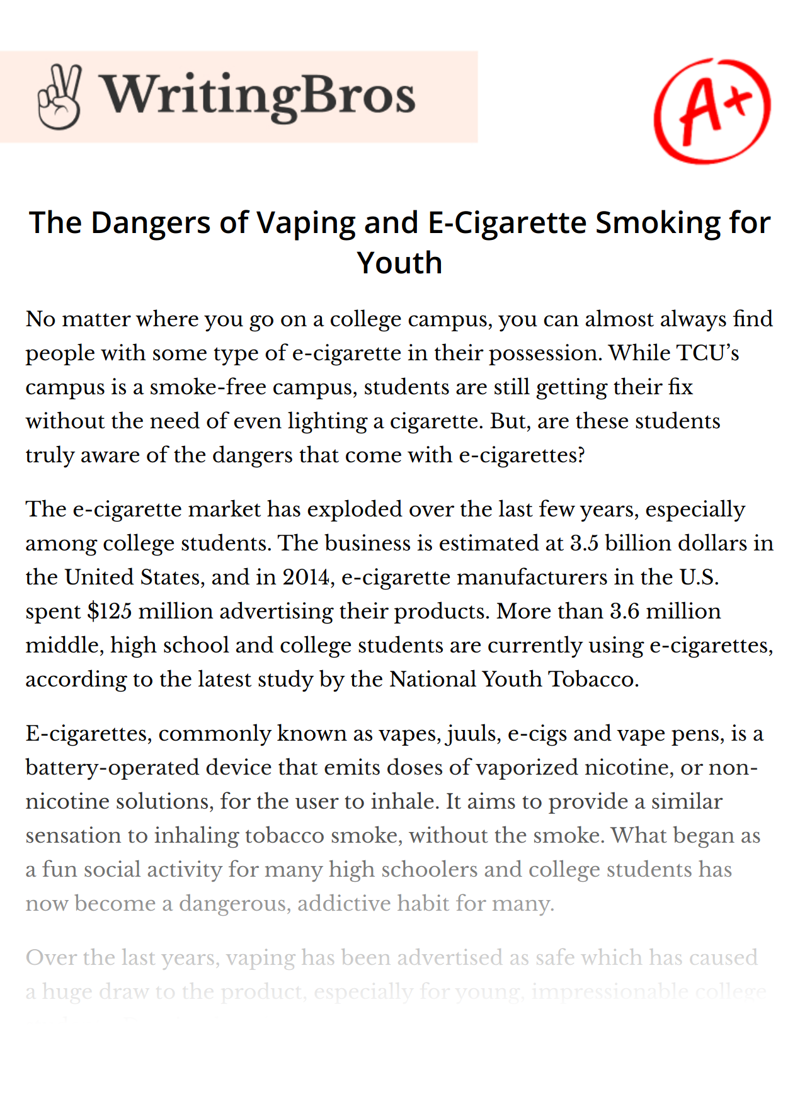The Dangers of Vaping and E-Cigarette Smoking for Youth

No matter where you go on a college campus, you can almost always find people with some type of e-cigarette in their possession. While TCU’s campus is a smoke-free campus, students are still getting their fix without the need of even lighting a cigarette. But, are these students truly aware of the dangers that come with e-cigarettes?
The e-cigarette market has exploded over the last few years, especially among college students. The business is estimated at 3.5 billion dollars in the United States, and in 2014, e-cigarette manufacturers in the U.S. spent $125 million advertising their products. More than 3.6 million middle, high school and college students are currently using e-cigarettes, according to the latest study by the National Youth Tobacco.
E-cigarettes, commonly known as vapes, juuls, e-cigs and vape pens, is a battery-operated device that emits doses of vaporized nicotine, or non-nicotine solutions, for the user to inhale. It aims to provide a similar sensation to inhaling tobacco smoke, without the smoke. What began as a fun social activity for many high schoolers and college students has now become a dangerous, addictive habit for many.
Over the last years, vaping has been advertised as safe which has caused a huge draw to the product, especially for young, impressionable college students. Despite that claim, there have been 6 deaths over the last 3 weeks related to Juuls and Vapes.
Haley Polk, a TCU student, shared her distaste for the habit by saying, “This trend is ridiculous. People would rather look cool by continuing to vape rather than fight their nicotine addiction. Literally, people are dying, but yet more and more people continue to vape.”
From 2017-2018 research found that the use of e-cigarettes doubled in use due to it being advertised as a safer substance for you than a regular cigarette. According to the FDA, Food and Drug Administration, there is 93 harmful or potentially harmful chemicals found in regular cigarettes. The NCI, National Cancer Institute, describes cigarettes as having more than 7,000 chemicals in them. E-cigarettes contain fewer chemicals and so the industry has presented them as a so called healthier alternative. But vapes still contain nicotine which is a highly addictive drug.
One Vape, (or Juul) pod is equivalent to one pack of cigarettes, which contains 40 mg of nicotine. Many young users are going through several of these pods a day. 22-year-old Makenna Markovich states that one time she went through 3 pods in one day.
“Sometimes I get really bad chest pains and have a hard time breathing and I know it because of my vape. I wish that states would ban it to force me to stop. I know it is dangerous, but I can’t help myself. I need a ban to force me to quit,” Markovich said.
According to Brad Stewart, the associate director of the TCU Wellness Center, many students don’t realize the addictive and harmful effects of e-cigarettes when they first start using them.
Recently, a local Fort Worth-area teen was hospitalized for eighteen days at Cook Children’s Medical Center 10 of which were spent in a medically induced coma with a breathing tube. While his doctors can’t say with certainty, they believe the failure of his lungs was caused in part by his vaping addiction. While this was the first case, they had seen at Cook Children’s, the hospital has seen an increase in the number of emergency room patients who reported chest pain and shortness of breath due to vaping over the past few months.
Vaping has become a critical issue among teens and young adults. The dangers and long-term health effects caused by e-cigarettes need to continue be a wide-spread concern. This is a message that is continuing to be spread around high schools and college campuses.
Cite this Essay
To export a reference to this article please select a referencing style below

